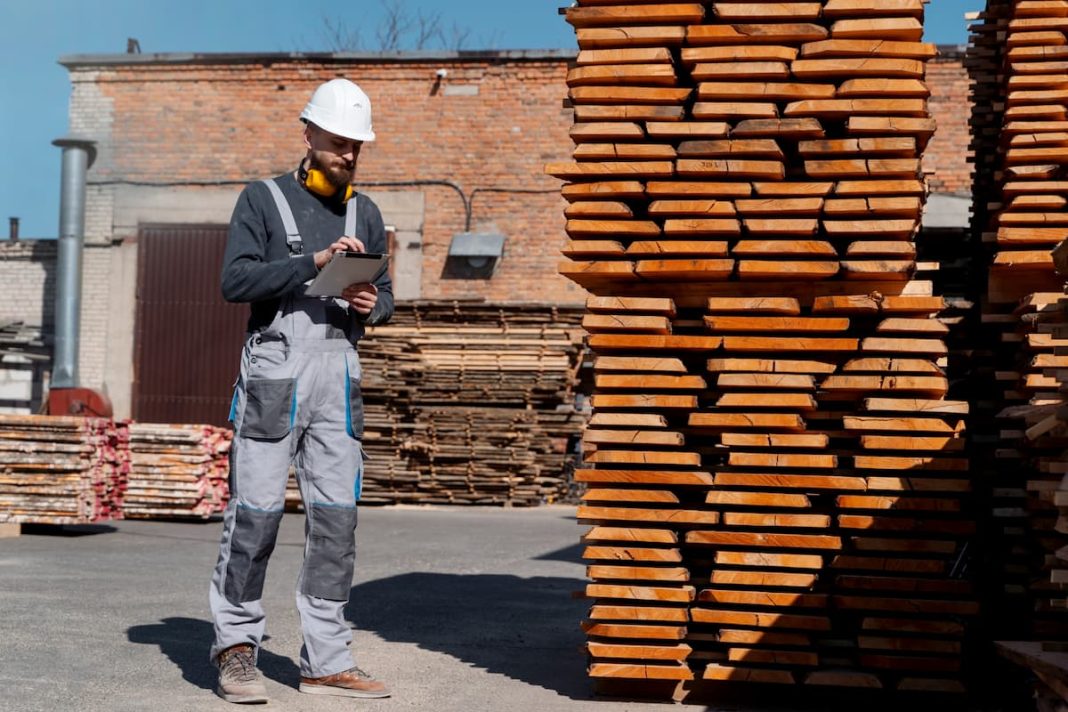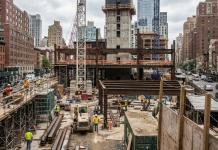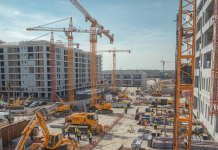In today’s US construction, read about Following a brief delay due to staff detention by U.S. immigration officials, LG Energy Solution has resumed construction of its joint battery factory (HL-GA) with Hyundai Motor Group in Georgia, USA, according to Pulse, the English-language edition of Maeil Business Newspaper Korea. Meanwhile, in the United States, mass timber construction started in 2015, and since then, the number of projects has increased by roughly 20% a year. Finally, workers just installed the last steel beam for the main production building at the LEGO Group’s new 1.7-million-square-foot manufacturing facility in Chesterfield County, Virginia.
Construction of LG Energy Solution’s U.S. Factory Resumes Following Detention Hardship
Original Source: LG Energy Solution resumes U.S. plant construction after detention ordeal
Pulse, the English service of Maeil Business Newspaper Korea, stated that LG Energy Solution and Hyundai Motor Group have begun construction of their joint battery factory (HL-GA) in Georgia, USA, after U.S. immigration authorities detained personnel.
Since staff who were held last month have returned to work, the company has accelerated site work. A month-long paid leave for the Chuseok holidays ended on Tuesday for LG Energy Solution and partner personnel, according to the article. This follows the “Georgia detention incident,” which halted project construction in early September.
LG Energy Solution officials said, “Since the plant has not yet entered full-scale operation, our initial focus will be on ensuring the construction progresses smoothly. We will analyze the U.S. business environment and visa risks before finalizing manpower deployment plans.
Soon, business excursions to the site will resume for LG CNS, Hyundai Engineering, and other project-related organizations and partner staff.
Washington also assured short-term business (B-1) visa holders and those entering under the Electronic System for Travel Authorization (ESTA) that they could install and inspect equipment, which could speed up Korean companies’ operations, during a recent Korea-U.S. working group meeting.
The speedy return of essential staff a month after the detention incident shows rapid healing, according to an industry official. The HL-GA project’s restart should improve LG Energy Solution’s North American operations.
American and European Eco-friendly Wooden Constructions Are on the Rise
Original Source: Climate-friendly wooden buildings rise across U.S. and Europe
Sustainable construction materials like mass wood are gaining popularity in the US despite funding cuts and open rejection.
Since 2015, the construction of mass timber buildings in the U.S. has climbed 20% yearly. In the U.S., approximately 2,500 large timber projects are underway, including Google, Microsoft, and Under Armour corporate buildings.
Ricardo Brites, director of engineering and virtual design and construction at Mercer Mass Timber, told Woodworking Network that this is a “pivotal year” for mass timber building.
Structurally built timber beam buildings are climate-friendly and beneficial for employees, with lower embodied carbon and positive occupant impacts.
We have many tech and giant companies saying, “Hey, we’re competing for labor.” “We want the best space possible,” said Bill Parsons, COO of WoodWorks, a nonprofit timber construction industry association. Good offices, usually wood ones, are significant to people.
The mass timber comparison
The UN Environment Program reported in 2023 that buildings and construction emit 37% of global greenhouse gases. Manufacturing cement and steel for construction emits 11% of world emissions.
Mass wood is a sturdy beam constructed of layers of lumber cemented together. The two most prevalent types are cross-laminated timber, which stacks lumber boards like a Jenga tower, and glue-laminated timber, which stacks boards in parallel.
According to the UN research, replacing traditional building materials with mass timber may cut world emissions by 14–31%.
The Gensler-designed Under Armour building in Baltimore saved over 69% on embodied carbon by replacing steel and concrete with mass timber.
“Mass timber was a lead contributor in reducing the site’s carbon emissions and supported a quicker, more seamless construction process,” said Under Armour’s Kathleen Blessington, vice president of real estate, via email.
Some builders and authorities are apprehensive about mass timber buildings’ fire risk, but regulations in the U.S., France, and others have adjusted to tolerate multistory wooden buildings, which are fire-resistant like steel and concrete.
Virginia Tech associate professor of architecture Edward Becker stated mass timber’s fire resistance is well-known. The international building code modifications over the previous few years show the success of these fire tests and public safety.
However, responsible bulk timber sourcing is essential. The FSC and SFI certify products from ethically managed forests with deforestation safeguards.
Becker advised architects, designers, and construction managers to “check with the supplier.” “FSC and SFI sourcing are essential. That ensures ethical sourcing easily.”
Mass timber’s popularity rising
In the meantime, the Mass Timber Federal Buildings Act and USDA Wood Innovations Grant Program are still moving forward. Industry-wide effects from government funding decreases are evident.
Mercer Mass Timber chief operations officer Nick Milestone stated, “While we haven’t seen specific cuts to mass timber programs themselves, the broader forestry infrastructure that supports our industry is facing significant reductions.”
The 2024 International Mass Timber Report indicates consistent gains in Canadian and U.S. output from 158,000 cubic meters in 2019 to 393,000 in 2023, and the construction of mass timber buildings from 151 to 279 in that same period.
Mass wood is popular with builders for reasons other than its sustainability.
“I think sustainability has been further down as a benefit overall,” Parsons said. “People figured out how to make a very cost-effective, beautiful building,” I think.
Individual cost comparisons for mass timber against concrete or steel differ. According to Virginia Tech research, mass timber is more expensive upfront, but construction and life cycle savings can offset that. When a construction is finished, mass timber can be disassembled and reused.
Contractors may expect a 20-to-30% premium on standard construction materials for mass timber buildings, said Gensler principal and studio head JJ Rivers. However, mass timber is lighter than concrete, saving foundation costs. Quicker erection reduces labor expenses and schedule time.
Because mass timber is lighter and prefabricated, construction is faster, allowing tenants in sooner and rents to rise. Furthermore, bulk timber buildings have higher lease rates.
North American suppliers are trying to meet enormous timber demand. In the past decade, 13 new U.S. production factories opened. Builders still import from Europe, where the sector has matured for decades.
University of Washington research predicts that national forest cover will rise 18% by 2035 even under heavy logging.
Companies using mass wood
Environmental impact and cost are important, but occupant satisfaction is key in mass timber constructions.
Studies demonstrate that living or working in a mass wooden building, especially with exposed wood, enhances mental health and lowers blood pressure and pulse rate.
Becker stated, “It takes a little bit of explaining at first, but when people walk inside a mass timber building for the first time, especially when the wood is exposed, you really don’t need to explain anything else.” «The building feels, smells, and looks better.»
Corporations are turning to bulk wood for this reason.
We asked some Norwegian companies about their usage of mass timber structures, and they all indicated they would do it again because of how it makes their staff feel, Becker said. Their excellent work environments help them retain and attract top talent.”
The majority of mass timber constructions use concrete and steel, but growth is positive.
Milestone called hybrid buildings “the next big thing.” “I think the symbiosis of steel and mass timber is the future of North American construction.”
Lego Group’s First U.S. Manufacturing Campus Celebrates Construction
Original Source: LEGO Group’s First U.S.. Manufacturing Campus Reaches Construction Milestone
At its new 1.7-million-sq-ft manufacturing facility in Chesterfield County, Va., the LEGO Group installed the final steel beam for the main production building.
The Danish toymaker’s first U.S. manufacturing plant, built by a general contractor joint venture of Lexington, Ky.-based Gray and Richmond, Va.-based Hourigan, will have 13 buildings for molding, processing, and packing; offices; and a high-bay warehouse on a 340-acre site. LEGO plans to start manufacturing in 2027, two years after the 2023 groundbreaking. Reports cite LEGO’s completion of the construction contract and the design modifications made by architect LS3P Associates Ltd.
Due to LEGO’s company-wide goal of net-zero greenhouse gas emissions by 2050, the new plant is carbon-neutral and meets all daily energy needs with on- and off-site renewable energy systems. LS3P says the project will meet the highest LEED accreditation using roof-mounted solar panels, a rainwater recycling system, and timber buildings instead of steel and concrete.
A 2.5-foot LEGO brick tree was placed on the ceremonial final steel beam on Oct. 1, reminding the corporation of its plans to plant 17 native trees at all Chesterfield County parks to reduce construction’s environmental impact.
LEGO claims that the facility’s high-tech production technology will make each brick 1/10th of a hair wide. This precision lets new bricks match 60-year-old ones.
LEGO has approved a 2-million-sq-ft regional distribution center in Prince George, Va., to open alongside Chesterfield County toy manufacture. LEGO has invested almost $1.5 billion in Richmond, including the $366-million complex, which got a $2.3-million state grant.
The Virginia plant will join LEGO’s Monterrey, Mexico, production complex and Fort Worth, Texas, distribution hub as its second American manufacturing location.
In May, Structure Tone completed the construction of LEGO’s U.S. headquarters. LEGO opened its 157,000-sq-ft office in Boston’s Back Bay on May 15, but its move from Enfield, Conn., won’t be complete until next year.
Summary of today’s construction news
In summary, employees who were held last month have returned to their positions, terminating the temporary halt of on-site operations, and the corporation has accelerated work at the site. After taking a month-long paid leave that fell during the Chuseok holidays, LG Energy Solution employees and partner employees reported that they resumed work on Tuesday. This comes after the “Georgia detention incident” in early September caused a hiccup that momentarily stopped the project’s advancement.
Meanwhile, there are currently approximately 2,500 mass wood projects completed or under construction in the United States, with the number of these projects increasing by roughly 20% a year. By using mass timber instead of steel and concrete, the new Under Armour building in Baltimore reduced its embodied carbon by more than 69%. Although mass timber is typically more expensive initially, the increase can be leveled out by cost savings during construction and throughout the building’s life cycle.
Finally, together with a distribution hub in Fort Worth, Texas, and an existing production complex in Monterrey, Mexico, the Virginia plant will be LEGO’s second manufacturing location in the Americas. Structure Tone completed the construction of LEGO’s new U.S. headquarters in May. Even while LEGO’s 157,000-square-foot headquarters building in Boston’s Back Bay officially opened on May 15, the company won’t have finished moving from Enfield, Connecticut, until the end of the following year.








